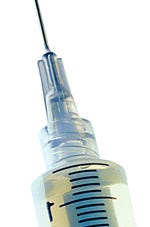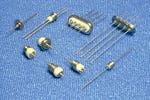September 2, 2001
Originally Published MPMN September 2001
HOTLINE
Static-Dissipative Compound Provides ESD Protection
Property is not compromised by surface scratches
|
The Vu-Stat C-37 static-dissipative compound is suited for the production of needle hubs. |
A static-dissipative compound provides permanent ESD protection to surfaces and parts sensitive to static discharge, preventing buildup of dirt and dust particles on cleanroom instruments, electronic medical components, and related items. Developed for injection-molded medical applications, the Vu-Stat C-37 compound from Cyro Industries (Rockaway, NJ) offers a balance of mechanical, thermal, and flow properties.
The compound's protection cannot be compromised by surface scratches or abrasions. Vu-Stat retains its permanent static-dissipative protection after repeated washing and provides 80% light transmittance in standard 1/8-in. thicknesses. The compound is available in pellet form and can be processed under typical acrylic multipolymer conditions in all types of injection molding presses.
Jamie Graham
Cyro Industries, 100 Enterprise Dr., Rockaway, NJ 07866; phone: 800/631-5384; fax: 973/442-6117; URL: www.cyro.com
Noncochlear Implants Use Ceramic-to-Metal Seals
The construction increases reliability and durability
|
Ceramic-to-metal seals on these noncochlear implants from Morgan Advanced Ceramics–New Bedford minimize the possibility of device failure. |
Noncochlear implant components from Morgan Advanced Ceramics–New Bedford (New Bedford, MA) have seals that are constructed from a variety of metals and high-purity alumina ceramic. Designed with flexibility for custom applications, these materials increase reliability and durability. "Previously, noncochlear implants used glass-to-metal seals that often cracked when the wires bent," says business unit manager Dave Bialka. These new materials are sturdier and allow for a repeatable manufacturing process that can meet customer specifications and reduce costs. Because the materials are also biocompatible and corrosion resistant, the implants can be used in extreme conditions. "The components have a number of other advantages, including sensitivity to a wide range of sounds, a battery that lasts 3 to 5 years, and a cosmetically pleasing appearance," adds Bialka. Resistance to thermal shock and small feedthroughs are also cited as benefits. Produced at an ISO 9002–certified facility, the implant assemblies are 100% traceable.
Zachary Turke
Morgan Advanced Ceramics–New Bedford, New Bedford, MA; URL: www.alberox.com
Gas Springs Provide Uniform Force Progression
Units are available with dynamic or hydraulic damping
|
The Stabilus Lift-O-Mat springs have linear spring curves to ensure consistent force progression. |
Gas springs from SKF (Göteborg, Sweden) feature linear spring curves that provide uniform force progression over their entire travel lengths. Available in four versions, the Stabilus Lift-O-Mat springs have piston rod diameters of 6–20 mm and force ratings of 50–5200 N. The Hydro-Lift version can be positioned at any desired point; high-friction models are suitable for stepless positioning; and the Electro-Lift version is capable of electrically switching during operation. Suited for such tasks as flap positioning, the Inter-Stop model can have its stroke divided into a number of functional areas. Typical medical applications include hospital beds and rehabilitation equipment. The springs are available with dynamic or hydraulic damping, depending upon the application and fitting position.
Zachary Turke
SKF, Göteborg, Sweden; phone: +46 31 3371000; fax: +46 31 3372832
Copyright ©2001 Medical Product Manufacturing News
You May Also Like





